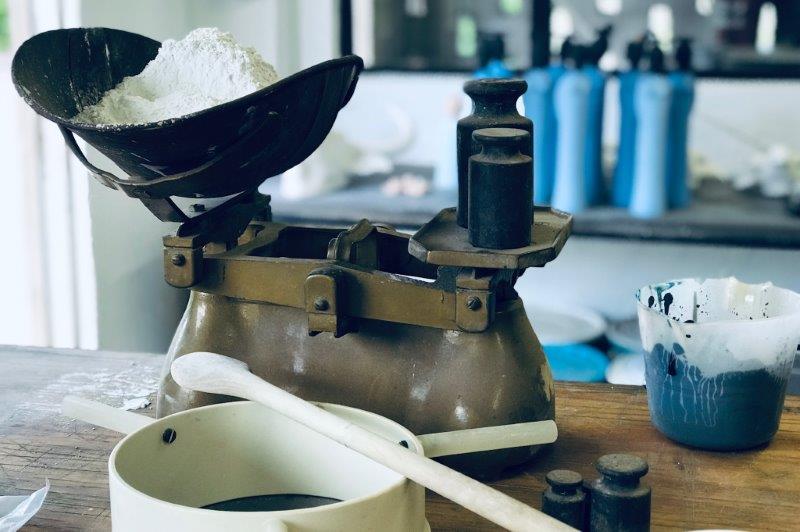The Sacred Studio Space..

Artist Trayci Tompkins shares her thoughts on artist’s creative spaces with readers of the Ceramics Southern Africa Magazine.
Having a studio to call your own doesn’t require tons of money, lots of space or even necessarily a door. As long as it’s your sacred place, that’s really all that matters.
Kimberly Brooks (Huffington Post)
44-years-ago, a young and aspiring potter, Ian Glenny trudged knee deep through a swollen Dargle flood to find his piece of paradise. A place where he would settle, build his eclectic home and sprawling mix of pottery studios and showroom gallery. Today Ian sits nestled amongst his years of creativity in a studio space that reflects his remarkable journey with clay.
This is one of South Africa’s best known working studios that has seen busy expansion, some quiet idle times and now fresh energy once again. Alongside Glenny’s collection of signature works, sits production fireplaces, hand thrown Tagines and terracotta garden pots. It’s an inspiring space of ergonomic up-cycled architecture, electric and wood fired kilns, clay making equipment and unglazed clay shapesfilling every conceivable corner. One can get lost meandering through the 600 square meters of studio and Gallery that humbly reflects very much the personality and creativity of its maker.
In sharp contrast to a sprawling studio space is the quaint and highly efficient studio of UK potter Paul Young. Occupying a gorgeous Victorian railway station in Warwickshire, in the heart of England, I couldn’t imagine a studio more fitting for both Young and what he terms his ‘new style old pots’ and Staffordshire inspired sculpture. Young and his clay work equally celebrate history, and their iconic studio station house, situated alongside King Richard III battle of Bosworth site, has become a notable landmark.
“Arriving early to open up the pottery, I enjoy the solitude of the early mornings, the open countryside and wildlife that surrounds me here,” says Young.
“My studio reflects the type of person I am and is the perfect combination to be making new style pots from within the four walls of an old building.”
These are the stories I enjoy about artists and the spaces in which they produce. I love how studios become an artist’s second skin and ultimately inspire the works that are created within their very solid and stable walls.
Equally I embrace the idea of ‘Transartists’ where creative’s combine the itch of travel with sub-letting their own studio space for something similar abroad. Likened to the Airbnb concept, studio exchanges or international studio swops are becoming increasingly popular as artists seek new horizons, alternative inspirations and global opportunities.
Whether it be a large traditional studio space, charming intimate space or shared transient studio – the romanticism of the artist and their art studio is alive and well for me. I love the opportunity to catch a glimpse, like a window into an artists’ creative world. I particularly enjoy studio’s cluttered with character as well as multi-functioning spaces. I’m intrigued at the way Fine Artists select their spaces of work and thoughtfully place their easels to garner maximum light; the way a potter considers efficiency, storage, contamination and ventilation; and the way a sculptor arranges tools, table heights and lighting.
It’s this thought-provoking, ever evolving metamorphosis that goes on behind the scenes in every artists’ studio space that often we take for granted. Considering we spend most of our days tucked away within the security of those four walls – how creatively inspired do we feel in our individual spaces? How efficient are these spaces that evolve, tailoring to our personal and specific needs?
Having recently downsized and reduced my large and dusty ceramic production studio to a manageable and efficient 40 square meters all to myself, I’m revelling in my new re-created world. Now is my chance to put back things I consider important into my creative process. To split my space between hand-building in clay, a new-found interest in painting – and an all-important siesta zone where I read, rest and recharge.
This new beginning has reminded me that a studio is a sacred space where an artist can completely lose oneself in the process of creating. A place where we can both succeed and fail – which inevitably leads to confidence and certainty about a direction of both our artwork and our careers.
So, whether you rent a studio space; dedicate a suitable space in your home or create a bespoke stand-alone studio, this is what becomes the artists’ ‘headquarters of creativity’!
First published in CERAMICS SOUTHERN AFRICA magazine issue 15/2019
Recent Comments